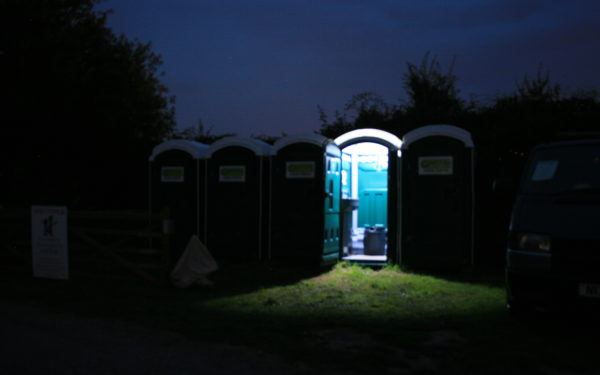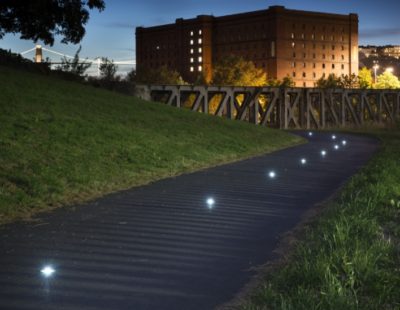Here at Solareye, we are proud of our innovative Solareye80 solar ground lighting. The independent units provide light in towns, cities and beyond during the dark hours using renewable energy, with minimal environmental impact. When it comes to wowing customers, our Solareye80 units do all the work, but we do commonly get asked how exactly they work. It’s understandable, it all sounds a bit too good to be true – but it’s not!
In this blog we explain exactly how solar lights work, as well as provide answers to other solar light questions you may have. Check out our 5 FAQs blog for more information.
For more detailed technical information about the Solareye80, download our technical specification >
How do solar lights work?
Solar lights are, as the name states, lighting units powered by solar energy. Using this ‘green’ energy, solar lights charge up then emit light during dark hours. The main components are usually a solar rechargeable battery, an LED light and a photoresistor (which detects the absence of light). It is the photovoltaic process that converts solar energy to usable electricity.
The process of powering solar lights is as follows:
- – The “Photovoltaic” (PV) cells gather energy – during daylight hours, the units use sunlight to charge their internal batteries using a solar cell.
- – The solar light turns on – most solar lights have built-in sensors to detect low light i.e. at dusk. This triggers the cell to power the battery and turn on the light.
- – The solar light turns off – when light levels rise outside, like at dawn, the lights turn off.
- – The solar light recharges – every day the unit charges. Charging may be less effective during days with less direct sunlight, like during winter, but high-quality units will still charge and work during darker days.
And that’s it! Once installed, solar lights can last any number of years depending on the quality and provider. No wiring or mains electricity, just simple, green energy.
See more: IP68 Certifies – What Does IP68 Mean?
Do solar lights need batteries?
No! They already contain a battery that is charged via solar power. There is no need to replace this as the battery is integral to the working of the light and should last many years depending on the manufacturer.
In our Solareye80 units, we have a long life LFP battery with an estimated life of over 8 years, so you needn’t worry for quite some time.
See more: What is Eco-Friendly Lighting? Everything You Need to Know
Do solar lights need sun or any light?
Most solar lights require solar light from daylight, not artificial light. Although artificial light might have some effect and allow for charging, the speed and effectiveness would not be as such with daylight.
Do solar lights work in winter/in the shade?
Yes – just not as effectively.
Direct solar light, like in the height of summer, is when charging of solar light units is most effective. Essentially, the more sunlight received, the longer or the stronger the light will stay illuminated. However, there is still sun in winter, albeit not always direct, which will charge solar lights. The same goes for shade; solar lights will still charge in shade, just slower.
Our Solareye80 solar ground lights have been specially designed for Northern European conditions and on a full charge (8 hours on a sunny day) will illuminate for over 200 hours, which equates to 8 full days or 2 weeks of January nights. This means performance is optimised and charge is reserved for cloudier days. Also, the working temperature spans -20°C – +70°C so there is no need to worry about working conditions.
How long do solar lights stay on for?
Most solar lights have an auto on/off detection system and will turn off when not needed during light hours. On a full charge, our solar lights can illuminate steadily for 200+ hours or 300+ hours flashing.
Where can solar lights be installed?
Solar lights can be installed practically anywhere as long as there is access to sunlight as they don’t require wiring for power; therefore, they must be outside. Solar lights are used as ground lighting, bollards, lamps, or even in roofs – perfect for outhouses and sheds.
Find out more about Solareye roof lighting or read our blog on solar roof lights.
Just to note: if installing units to vertical walls or fences, the units need to receive at least some direct sunlight for optimal performance. If unsure on the best placement, ask the manufacturer and they can advise.
See more: The Ultimate Guide to Ground Lighting
How are solar lights installed?
Depending on the application, solar light installation can vary from ground installation to roofs. As no wires or additional power is needed, solar light installation is super simple!
View our Solar Ground Light Installation Guide >
Usually, solar lights are simply fixed to a surface or slotted into a small, drilled hole. You can always install units yourself, following expert advice, or let us do it! We offer installation packages to ensure a professional service from purchase to use. Get in touch to find out more!
Are solar lights good for the environment?
Yes! For all sorts of reasons!
Solar lights use renewable energy, reduce greenhouse gas emissions, have less infrastructure requirements, are long-lasting solutions, and can even reduce light pollution with great effects on nocturnal animals. Our innovative Bat Hat solution reduces the upward spillage of light to minimise disruption to nocturnal animals such as bats in towns and cities, adding to the great benefits of our solutions!
Quality solar lights from Solareye
Ready to begin your solar light journey? Solareye are here for you. We regularly work alongside councils, local authorities, and private clients to line cycle paths, river walks, country lanes and more. View our case studies to see our versatile units in action.
Got any questions? Get in touch and one of our friendly team will assist with your enquiry.





